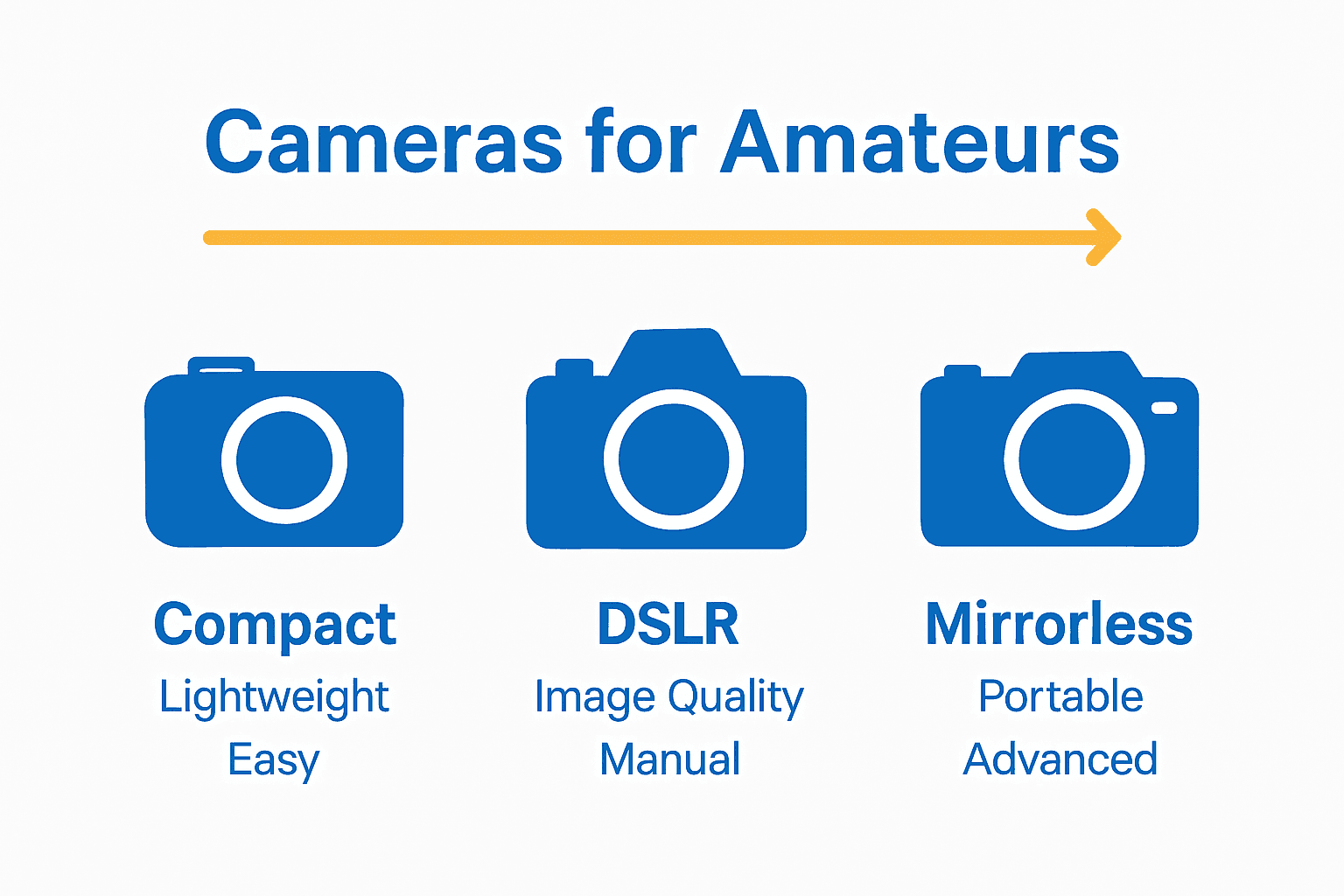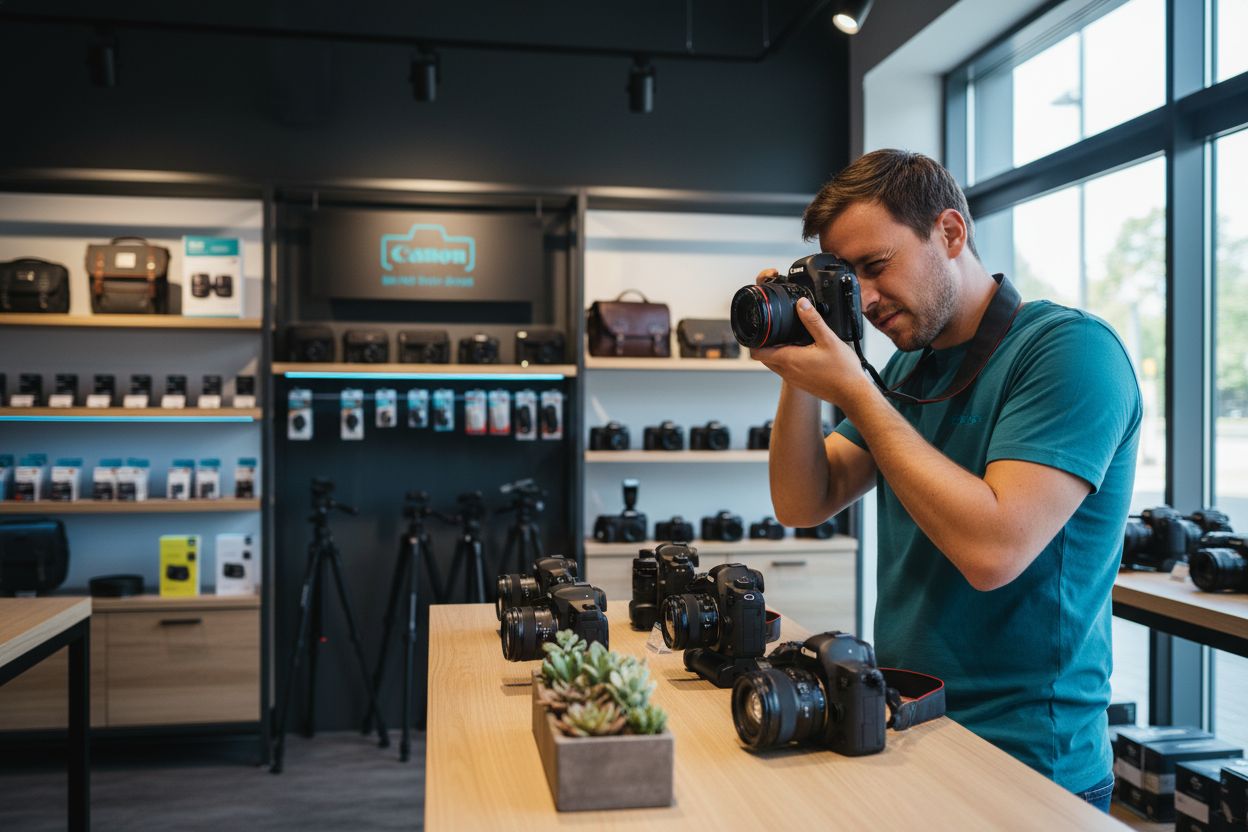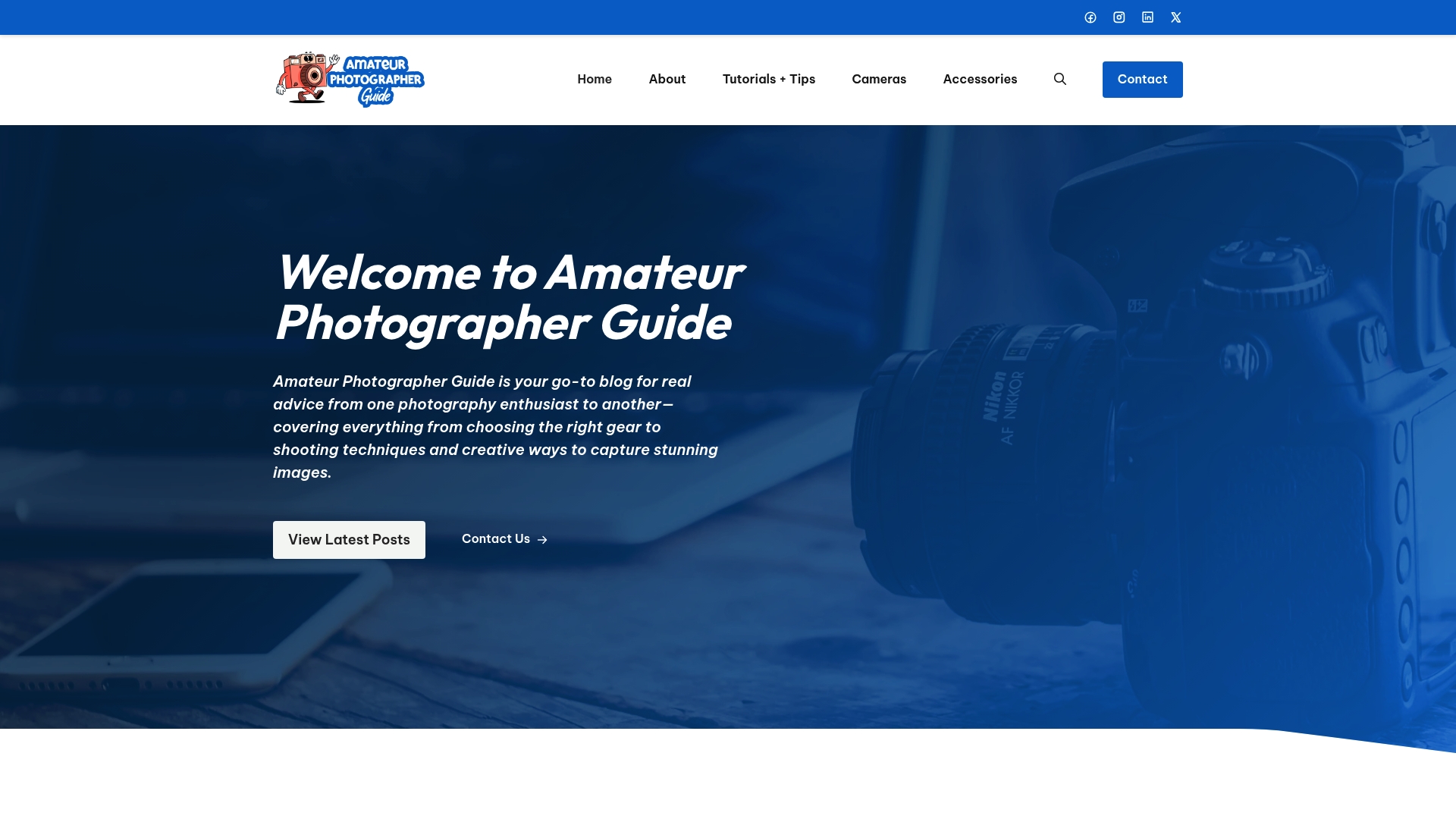Table of Contents
- Quick Summary
- Table of Contents
- Step 1: Assess your photography needs and goals
- Step 2: Compare camera types and key features
- Step 3: Set your budget and narrow options
- Step 4: Test shortlisted cameras in real scenarios
- Step 5: Evaluate sample photos and usability
- Step 6: Confirm your final camera choice
- Ready to Choose Your Perfect First Camera?
- Frequently Asked Questions
- Recommended
This blog post may contain affiliate links. As an Amazon Associate I earn from qualifying purchases.
Over half of amateur photographers say their first camera influenced how much they enjoyed learning photography. Choosing the right camera can shape not only your photos but also your confidence and creativity. Whether you want to capture vibrant memories, grow as an artist, or simply have fun, understanding how to pick the perfect camera makes a huge difference from the very first shot.
Quick Summary
| Key Point | Explanation |
|---|---|
| 1. Clearly define your photography goals. | Understanding your purpose helps select the right camera type and features to meet your needs effectively. |
| 2. Assess your budget accurately. | Prioritize your spending on essential items, ensuring your investment aligns with your commitment to photography. |
| 3. Test cameras in real conditions. | Hands-on testing helps you evaluate weight, comfort, and usability, making the selection process more informed. |
| 4. Evaluate sample photo quality. | Analyze sample images to gauge camera performance across different lighting, ensuring it meets your creative expectations. |
| 5. Trust your instincts alongside specifications. | Choose a camera that feels right for you personally, as comfort and inspiration are key to your photography journey. |
Table of Contents
- Step 1: Assess Your Photography Needs And Goals
- Step 2: Compare Camera Types And Key Features
- Step 3: Set Your Budget And Narrow Options
- Step 4: Test Shortlisted Cameras In Real Scenarios
- Step 5: Evaluate Sample Photos And Usability
- Step 6: Confirm Your Final Camera Choice
Step 1: Assess your photography needs and goals
Before diving into camera shopping, understanding your photography goals is the foundational step that will guide every purchase decision. Think of this like selecting the right tool for a specific job your camera needs to accomplish.
Start by getting crystal clear about why you want a camera. Are you hoping to capture stunning travel memories, document family milestones, explore photography as a passionate hobby, or potentially develop professional skills? Each purpose demands different camera capabilities.
If you are a traveler wanting lightweight portability, you might prioritize compact size and durability. Family photographers might focus on ease of use and good indoor performance. Creative hobbyists could seek cameras with interchangeable lenses that allow skill progression. read more about photography essentials for beginners to understand how your goals shape equipment choices.
Consider your current skill level too. Complete beginners should look for user friendly cameras with automatic modes that simplify initial learning. More experienced photographers might want advanced manual controls that provide greater creative flexibility.
Pro Tip: Your first camera should inspire you to shoot more not intimidate you with complex settings.
Budget matters as well. While top tier professional cameras can cost thousands, excellent starter cameras exist in the 300 to 800 dollar range that deliver impressive image quality and room for growth. Match your investment to your genuine commitment level.
Once you have clarity about your photography goals expectations and budget range you will be perfectly positioned to make a smart camera selection that matches your creative vision.
Step 2: Compare camera types and key features
Now that you know your photography goals, let’s explore the camera landscape and understand which type might suit you best. Think of this as matchmaking between your creative vision and the right photographic tool.
Here’s a comparison of the three main camera types for amateurs:
| Camera Type | Key Strengths | Ideal User |
|---|---|---|
| Compact Point & Shoot | Lightweight Easy to use Affordable |
Travelers Casual users |
| DSLR | Superior image quality Manual controls Interchangeable lenses |
Hobbyists Aspiring professionals |
| Mirrorless | Compact Near DSLR quality Advanced features |
Hobbyists Travelers seeking performance |
Amateur photographers typically choose between three main camera types: compact point and shoot, DSLR, and mirrorless cameras. Each has unique strengths that align differently with photographer needs.
 learn more about choosing the right camera style to make an informed decision.
learn more about choosing the right camera style to make an informed decision.
Compact cameras are lightweight and simple. Perfect for travelers and casual photographers who want quick snapshots without technical complexity. They are affordable but offer limited creative control and smaller sensors that struggle in low light conditions.
DSLR cameras provide professional grade image quality with larger sensors and interchangeable lenses. They excel in capturing detailed images across various lighting conditions. These cameras offer more manual controls and better performance for serious hobbyists willing to invest time in learning.
Mirrorless cameras represent the newest technology. They combine compact size with near professional image quality. Weighing less than DSLRs but offering similar advanced features, they strike an excellent balance for photographers seeking portability and performance.
Pro Tip: Consider your comfort with technology. Some cameras have steeper learning curves than others.
When comparing features, pay attention to critical technical specifications. Look for cameras with good ISO range (around 100 to 6400 for versatile low light performance), reliable autofocus systems with multiple focus points, and effective image stabilization.
Battery life, connectivity options, and video capabilities are additional factors worth considering. Some cameras offer wifi transfers, 4K video recording, and smartphone integration that can enhance your photography experience.
Remember that the best camera is not about having the most expensive model but finding one that feels comfortable in your hands and motivates you to keep shooting.
Step 3: Set your budget and narrow options
Budget planning is where your photography dreams meet practical reality. Think of it as creating a financial roadmap that ensures you get the best camera without breaking the bank or feeling overwhelmed by unnecessary expenses.
Most quality amateur cameras fall within the 500 to 1000 dollar range. This sweet spot offers excellent image quality, reliable performance, and room for skill development. check out our guide on buying a digital camera to understand pricing nuances.
Dont just budget for the camera body. Factor in essential accessories that transform your photography experience. Extra batteries, memory cards, a sturdy tripod, protective bag, and potentially additional lenses can quickly add 200 to 500 dollars to your initial investment.
If youre starting out, consider these budget allocation strategies. Allocate about 60% to 70% of your total budget for the camera body and primary lens. Reserve the remaining funds for accessories and potential future lens upgrades.
Pro Tip: Buy the best camera you can afford right now that meets 80% of your needs. Photography is about growth and learning.
Look for bundle deals that include multiple accessories. These packages often provide better value compared to purchasing items separately. Some retailers offer student or beginner discounts that can help stretch your budget.
Consider purchasing slightly older model cameras. They often provide exceptional value as newer models hit the market. These cameras have proven reliability and significantly lower prices compared to the latest releases.
Remember that your first camera is a learning tool. Prioritize ease of use and features that match your current skill level over having the most advanced specifications. A camera that feels comfortable and inspires you to keep shooting is worth more than technical perfection.
Step 4: Test shortlisted cameras in real scenarios
Now comes the most exciting part of your camera journey testing potential cameras in real world conditions. This step transforms theoretical research into hands on experience that reveals which camera truly feels right for you.
Visit local camera stores or photography shops where you can physically handle different models. explore our guide on finding the right camera setup to complement your hands on testing.
When testing cameras, simulate the environments where you plan to shoot most frequently. If youre a travel photographer, ask to test the cameras weight and size. Check how comfortably it fits in your hand and how quickly you can access key settings.
For indoor shooting enthusiasts, test low light performance. Take sample shots in dimmer store lighting and examine image quality on the camera screen. Check how quickly the autofocus locks onto subjects and how noise appears in darker conditions.
Videographers should pay special attention to video recording capabilities. Test smooth focus transitions, stabilization features, and sound recording quality. Some cameras excel in photography but struggle with video performance.
Pro Tip: Bring a memory card and transfer test shots to your computer. Screen images look different than actual file quality.
Evaluate user interface intuitiveness. A technically perfect camera becomes frustrating if its menu system feels complicated. Some cameras offer touchscreen controls while others rely on traditional button interfaces. Choose what feels most natural to your workflow.
Dont rush the testing process. Spend at least 15 to 20 minutes with each camera.
 Take multiple shots. Adjust settings. Get a genuine feel for how the camera responds to your touch and shooting style.
Take multiple shots. Adjust settings. Get a genuine feel for how the camera responds to your touch and shooting style.
Remember that technical specifications only tell part of the story. The right camera should feel like a natural extension of your creative vision something that inspires you to keep learning and exploring photography.
Step 5: Evaluate sample photos and usability
Evaluating sample photos is like test driving a car youre not just checking specifications but experiencing how the camera performs in real world situations. This step helps you understand whether a camera truly matches your creative vision and technical needs.
Start by requesting sample images directly from the camera manufacturer or browsing online photography forums. discover expert tips for processing your photos to complement your evaluation process.
Examine image quality across different lighting conditions. Look closely at JPEG outputs straight from the camera. Some brands like Fujifilm are known for exceptional in camera image styles that require minimal post processing. Check how colors appear natural or slightly saturated and how much detail is preserved in shadows and highlights.
Test the cameras autofocus reliability by looking at sharp focus points in sample images. Pay attention to how quickly and accurately the camera locks onto subjects especially in challenging environments like low light or with moving objects.
Zoom into sample images at 100% view to assess digital noise levels. Amateur photographers often struggle with image quality in dimmer settings so scrutinize how clean the images look at higher ISO settings.
Pro Tip: Dont just look at perfect studio shots. Find real world images taken in conditions similar to your typical shooting environment.
Evaluate the cameras handling through sample images. Do the photos look like they were easy to compose? Check if the cameras ergonomics translate into comfortable shooting experiences by examining the framing and overall image quality.
Consider the cameras built in image processing capabilities. Some cameras offer creative filters and styles that can instantly transform your photographs without extensive editing. These features can be game changers for photographers who want quick compelling results.
Remember that technical perfection isnt everything. The right camera should inspire you to keep shooting and exploring your creative potential.
Step 6: Confirm your final camera choice
Congratulations. Youve reached the final decision point in your camera selection journey. This moment is about more than just purchasing equipment its about choosing a creative companion that will grow with your photographic skills.
review key considerations when buying a digital camera to double check your selection matches your photography goals.
Take a moment to revisit your initial photography objectives. The camera you select should align perfectly with your intended use whether youre capturing family memories, exploring landscape photography, or documenting adventure travels. Your chosen camera should feel like an extension of your creative vision.
Consider the lens ecosystem as much as the camera body itself. Quality lenses are long term investments that often outlast the camera bodies. Some photographers spend more on lenses than camera bodies because superior glass dramatically improves image quality.
Evaluate your potential cameras compatibility with future upgrades. Many camera systems offer upgrade paths that allow you to expand your kit gradually. This means you can start with a basic model and incrementally add more advanced components as your skills develop.
Pro Tip: Choose a camera system with a robust lens and accessory market. Flexibility matters more than initial specifications.
Factor in ongoing costs beyond the initial purchase. Consider battery prices replacement costs for accessories and the availability of third party support for your chosen system. Some camera brands have more affordable ecosystems than others.
Trust your instincts alongside technical research. The perfect camera is not just about specifications but how it feels in your hands and how it motivates you to keep learning and exploring photography.
Your first camera is a gateway to a lifetime of creative expression. Choose wisely but remember that passion and practice matter far more than having the most expensive equipment.
Ready to Choose Your Perfect First Camera?
Are you struggling to sort through endless camera choices and feeling unsure about technical jargon, budget considerations, or which features will really help you grow as a photographer? Our step-by-step guide above addresses the real frustrations that amateur photographers face like balancing usability against future potential, navigating confusing specifications, and making a budget-friendly decision that actually fits your creative goals. You do not have to figure it out alone.

Explore even more hands-on tips, clear checklists, and expert-backed camera recommendations tailored for hobbyists on Amateur Photographer Guide. Dive deeper into essential photography gear for beginners or take your decision-making further with our comprehensive digital camera buying guide. Take action today so you can stop second-guessing your options and start building your skills with confidence.
Frequently Asked Questions
How do I assess my photography needs before choosing a camera?
Start by identifying your photography goals, such as capturing travel memories or pursuing a hobby. Write down your specific requirements, like portability or usability, to guide your camera selection process.
What types of cameras should I consider as an amateur photographer?
As an amateur, consider three main types: compact point-and-shoot cameras for lightweight and ease of use, DSLRs for superior image quality and advanced controls, and mirrorless cameras for portability without sacrificing performance. Evaluate which type aligns best with your intended use and comfort level.
What is a realistic budget for an amateur camera?
A budget of $500 to $1,000 is typical for quality amateur cameras, allowing for good image quality and performance. Allocate around 60% to 70% of your budget for the camera itself and set aside the rest for essential accessories like memory cards and tripods.
How can I test cameras to see which one feels right for me?
Visit local camera stores to physically handle the cameras on your shortlist and take test shots. Spend at least 15-20 minutes with each model to evaluate weight, ease of use, and how comfortably it fits your hands.
What should I evaluate when looking at sample photos from potential cameras?
Examine sample photos for image quality in various lighting conditions, focusing on sharpness and noise levels. Look for images that reflect your typical shooting environment to ensure the camera meets your aesthetic standards.
How do I finalize my camera choice before purchasing?
Review your initial photography objectives, ensuring the selected camera aligns with your intended use and growth path. Confirm that it has compatibility with future upgrades, keeping in mind the lens ecosystem for long-term investment.
Recommended
- 7 Things To Look For When Buying A Digital Camera – Amateur Photographer Guide
- 7 Photography Gear Essentials Every Beginner Should Know – Amateur Photographer Guide
- What Pro Photographers Won’t Tell You: A Honest Camera Equipment List for Beginners – Amateur Photographer Guide
- Home – Amateur Photographer Guide

